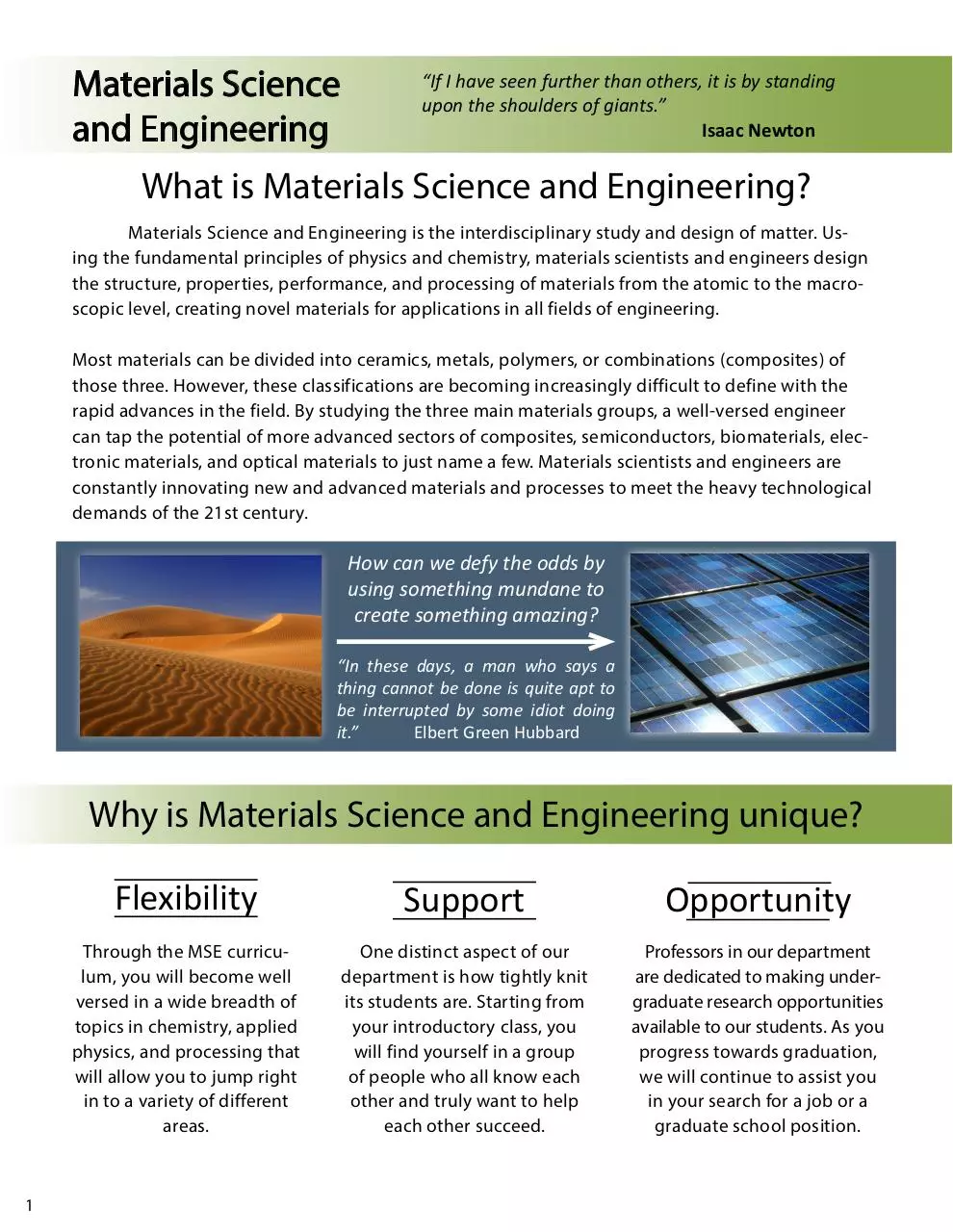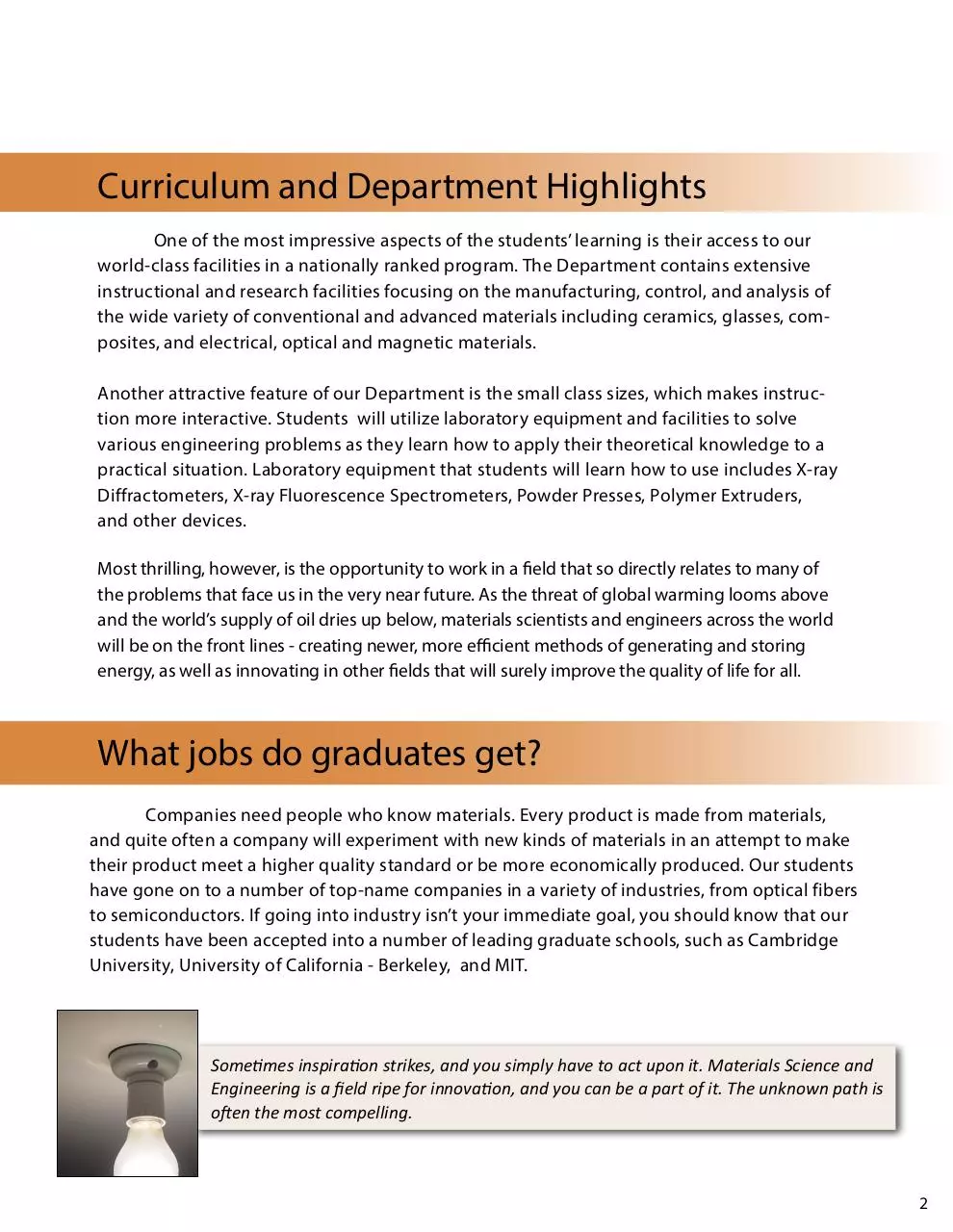Rutgers Publicity Yearsley (PDF)
File information
This PDF 1.4 document has been generated by Adobe InDesign CS5.5 (7.5) / Adobe PDF Library 9.9, and has been sent on pdf-archive.com on 06/09/2012 at 02:29, from IP address 68.232.x.x.
The current document download page has been viewed 1137 times.
File size: 5.66 MB (12 pages).
Privacy: public file





File preview
Materials Science
and Engineering
Materials Science
and Engineering
“If I have seen further than others, it is by standing
upon the shoulders of giants.”
Isaac Newton
What is Materials Science and Engineering?
Materials Science and Engineering is the interdisciplinary study and design of matter. Using the fundamental principles of physics and chemistry, materials scientists and engineers design
the structure, properties, performance, and processing of materials from the atomic to the macroscopic level, creating novel materials for applications in all fields of engineering.
Most materials can be divided into ceramics, metals, polymers, or combinations (composites) of
those three. However, these classifications are becoming increasingly difficult to define with the
rapid advances in the field. By studying the three main materials groups, a well-versed engineer
can tap the potential of more advanced sectors of composites, semiconductors, biomaterials, electronic materials, and optical materials to just name a few. Materials scientists and engineers are
constantly innovating new and advanced materials and processes to meet the heavy technological
demands of the 21st century.
How can we defy the odds by
using something mundane to
create something amazing?
“In these days, a man who says a
thing cannot be done is quite apt to
be interrupted by some idiot doing
it.”
Elbert Green Hubbard
Why is Materials Science and Engineering unique?
1
Flexibility
Support
Opportunity
Through the MSE curriculum, you will become well
versed in a wide breadth of
topics in chemistry, applied
physics, and processing that
will allow you to jump right
in to a variety of different
areas.
One distinct aspect of our
department is how tightly knit
its students are. Starting from
your introductory class, you
will find yourself in a group
of people who all know each
other and truly want to help
each other succeed.
Professors in our department
are dedicated to making undergraduate research opportunities
available to our students. As you
progress towards graduation,
we will continue to assist you
in your search for a job or a
graduate school position.
Curriculum and Department Highlights
One of the most impressive aspects of the students’ learning is their access to our
world-class facilities in a nationally ranked program. The Department contains extensive
instructional and research facilities focusing on the manufacturing, control, and analysis of
the wide variety of conventional and advanced materials including ceramics, glasses, composites, and electrical, optical and magnetic materials.
Another attractive feature of our Department is the small class sizes, which makes instruction more interactive. Students will utilize laboratory equipment and facilities to solve
various engineering problems as they learn how to apply their theoretical knowledge to a
practical situation. Laboratory equipment that students will learn how to use includes X-ray
Diffractometers, X-ray Fluorescence Spectrometers, Powder Presses, Polymer Extruders,
and other devices.
Most thrilling, however, is the opportunity to work in a field that so directly relates to many of
the problems that face us in the very near future. As the threat of global warming looms above
and the world’s supply of oil dries up below, materials scientists and engineers across the world
will be on the front lines - creating newer, more efficient methods of generating and storing
energy, as well as innovating in other fields that will surely improve the quality of life for all.
What jobs do graduates get?
Companies need people who know materials. Every product is made from materials,
and quite often a company will experiment with new kinds of materials in an attempt to make
their product meet a higher quality standard or be more economically produced. Our students
have gone on to a number of top-name companies in a variety of industries, from optical fibers
to semiconductors. If going into industry isn’t your immediate goal, you should know that our
students have been accepted into a number of leading graduate schools, such as Cambridge
University, University of California - Berkeley, and MIT.
Sometimes inspiration strikes, and you simply have to act upon it. Materials Science and
Engineering is a field ripe for innovation, and you can be a part of it. The unknown path is
often the most compelling.
2
Glass Melting and Forming Worskhop
Summer 2008
Students will have an opportunity to
participate in a variety of activities.
3
Princeton Plasma Physics Tour
Fall 2008
A Short Sample of Our Department’s Research...
Solar Energy
The total power of the sun is beyond our imagination. Even the small amount
of energy that breaks through our atmosphere is enormous, totaling 89 petawatts. To put that in perspective, the energy that falls on the earth in one
hour is more energy than the entire world uses in a whole year. The untapped
potential that exists is undeniable, and must be exploited if we are to create a
sustainable future. Demand has emerged for clean, cheap, and reliable energy
sources, and massive pushes have been made to further this effort in academic
research.
Dr. Dunbar Birnie has been working specifically
in the area of dye sensitized solar cells. This
promising new development in solar cell technology is designed as a possible low-cost, flexible
alternative to currently expensive and hard-to-produce silicon solar cells.
The creation of economically attractive solar panels could cause alternative energy utilization to skyrocket.
Battery Tech
Don’t think of batteries just as the AA’s in your camera. As the demand for
cleaner and more fuel efficient vehicles increases, the requirements for lighter,
smaller, and more efficient batteries will become of absolute importance to
the automotive industry. Next generation “plug-in” electric vehicles will rely
on arrays of high performance batteries to keep them going, and Rutgers research is helping to turn this potential into a reality.
Dr. Glenn Amatucci leads the Energy Storage
Research Group (ESRG), a technically diverse
applied research group of faculty, research
staff, graduate, and undergraduate students
that leads the way in the research and development of new energy storage device chemistries enabled by advancements in materials science.
4
Nanotechnology
Nanotechnology: the buzzword of the 21st century, and for good reason. By
modifying materials at the nanometer scale, or over 100,000th of the thickness of a human hair, we find that they act in ways that were never before
imagined. By modifiying a material at the atomic level we can make it exhibit
seemingly contradictory properties, such as simultanous high electrical yet
low thermal conductivity. With the power of nanotechnology, we have discovered exciting nanoscale applications for materials whose properties had been
exhausted on the macroscale.
Dr. Laura Fabris is a new faculty member in the
department. Her primary interests deal with the
creation of functionalized nanoparticles, including nanoparticles that are readily accepted by the body. These particles
could one day be used to deliver drugs directly to the part of the body
they are needed in, or act as specialized sensing mechanisms to detect
hard-to-find problems in the body.
Biomaterials
Great inventions have a way of imitating nature, quite simply because nature has
had the benefit of millions of years to improve upon itself. Until very recent times,
however, we haven’t been able to rival many of nature’s wonders. Scientists and
engineers have created high-density polymer hip replacements that last between
20 and 25 years, but they are easily outdone by nature’s own work, which usually
lasts over 60 years! Much of biomaterials research involves tricking the body into
re-growing work or broken parts, rather than trying to replace it with something
synthetic..
Dr. Richard Riman is working with novel applications of hydroxyapatite, a naturally occurring
mineral in the body. Not only can it be used as a
filler to encourage the formation of natural bone,
it can also be used to reconstitute the enamel of teeth. Basically, he hopes
to make fillings a thing of the past.
5
Armor Ceramics
Until the 1970’s, metal was the leader in armor technology. However, with the
development of armor piercing bullets came new challenges for protecting the
lives of infantry in the battlefield. Metal armor suddenly became utterly useless
against these new threats, but the solution to this problem came from an unlikely source: ceramics. Through developments of advanced ceramics not commonly
found in nature, such as Boron Carbide, light and effective body armor has been
designed for the modern soldier.
Dr. Richard Haber works in the processing and
development of armor ceramics to improve the
safety of troops in military conflict. Protecting
our soldiers in the battlefield is of paramount
importance to our military and the main focus
of our advanced ceramics research and development.
Flexible Electronics
It’s morning. After a long night’s sleep, you roll out of bed and walk over
to your window. You give the glass a light touch, and suddenly the glass is
ablaze with color. The date, time, and weather along with your calendar of
events come to life in a flash. However, you can see through the window just
as well as before. This could be reality with the development of thin film
display technology, and is just one of the many applications made possible
by flexible thin film electronics.
Currently, electronics must be printed onto
a stiff, rigid silicon circuit board. Dr. Manish
Chhowalla is working to overcome this boundary
by printing electronics onto thin polymer sheets
using inkjet printers similar to what you may have in your home right now.
With this technology, circuitry could be integrated into a boundless number
of new applications.
6
MSE Societies at Rutgers
Keramos is the professional society of ceramic engineers. Although the
department is no longer solely a ceramics department, we keep the tradition
alive by representing Keramos on a student chapter level. As a Keramos member,
you will be involved with maintaining the interaction between the faculty and
the students. We wrote the booklet that you’re reading right now, and helped
plan the lab tours that you hopefully went on as a freshman. In addition to this,
we also plan a variety of social events, such as paintball trips, bowling nights, and
the annual holiday party hosted in December.
As an honor society, a certain level of academic achievement is required to be
officially inducted into Keramos, but you can still become involved in the society
the second you become a part of the Materials Science and Engineering department.
Material Advantage
is our interdisciplinary material society, with student membership coming from the whole range of engineering
disciplines. The primary job of Material Advantage is to expose its membership
to a wide variety of educational and vocational experiences, including but not limited to laboratory
and factory tours, graduate school visits, and an annual trip to MS&T, one of the largest materials
conferences in the United States. They are also involved in high school outreach activities to promote
engineering and the sciences, and trade skills demonstrations for those who want to learn more about
welding, machining, and other hands-on skills. Also, by joining Material Advantage you will get access
to a variety of materials-related publications and automatic membership in four professional societies
for a fraction of their original cost, as well as access to exclusive scholarships.
Department Statistics
7
H
igh quality optics and
semiconductors were
made possible by materials
research.
8
Our Partner ...
The Metro New York-New Jersey Chapter, a 5 Star Chapter of Excellence, ASM International,
fosters interaction between its members and the Materials Advantage Chapter at Rutgers University. Over the past several years this interaction has included an open invitation to Rutgers
students to attend our technical meetings, including a free dinner, which has resulted in Rutgers students participating in most of our meetings. The benefit in holding meetings at Rutgers
has also been recognized. Our first regular technical meeting at Rutgers drew 55 attendees,
including Rutgers faculty and 36 students. The social hour and informal supper was structured to allow students
to question Chapter members on career opportunities in many different segments of the materials field and employment choices. An all day plant tour was organized by a Chapter member for students to provide an in-depth
look at a real life, cutting edge work environment.
Faculty/chapter cooperation is growing with a Rutgers faculty member on our Board of Directors. Interaction
between Rutgers, NJIT, Columbia University and other regional institution students and faculty takes place at
our meetings. The Chapter sponsors the Rutgers University summer Teachers Materials Camp and contributes
member participation and financial support. Most recently the Chapter made a separate contribution in support
of a Materials Advantage Chapter initiative at Rutgers. It is the Metro New York-New Jersey Chapter’s intent to
further develop beneficial interaction with Rutgers students and encourage suggestions from Materials Advantage students for additional productive initiatives.
For more details please go the following web site: http://www.asm-nynj.org/index/index.html
1st Rutgers ASM Chapter Meeting
Spring 2009
9
Department Information and Contacts
Professor
Specialties
Phone Number
Email Address
(732) 932-6856
gamatucc@rutgers.edu
Glenn G. Amatucci
Dunbar P. Birnie III
Energy, Nanomaterials
Thin Films, Nanomaterials, Processing,
Energy
(732) 445-5605
dbirnie@rutgers.edu
Manish Chhowalla
Nanomaterials, Electronic Materials,
Biomaterials, Energy
(732) 445-5619
manish1@rutgers.edu
Frederic Cosandey
Stephen C. Danforth
Nanomaterials
(732) 445-4942
cosandey@scils.rutgers.edu
Structural Materials, Nanomaterials,
Solid Freeform Fabrication
Energy, Nanomaterials, Polymers
(732) 445-2211
danforth@rutgers.edu
(732) 445-1653
adupasqu@rutgers.edu
Director of Institute for Advanced Materials, Devices, and Nanotechnology
Computer Simulations, Glass,
Nanomaterials
Processing, Structural Materials
(732) 445-4524
l.c.feldman@rutgers.edu
(732) 445-2216
shg@glass.rutgers.edu
(732) 445-3870
greenhut@alumina.rutgers.edu
Processing, Rheology, Ceramic Armor,
Clay-based Ceramics
Optical Materials, Electronic Materials
(732) 445-4931
rhaber1@rutgers.edu
(732) 445-3932
jaharrin@rutgers.edu
Nanomaterials, Electronic Materials,
Structural Materials
Processing, Structural Materials
(732) 445-2245
bkear@rutgers.edu
(732) 445-4711
khach@jove.rutgers.edu
Electronic Materials, Processing,
Thin Films, Nanomaterials
(732) 445-2096
licklein@rutgers.edu
Richard L. Lehman
Glass, Biomaterials, Processing,
Polymers
(732) 445-2317
rllehman@rutgers.edu
Adrian Mann
M. John Matthewson
Biomaterials, Nanomaterials
(732) 445-8421
abmann@rutgers.edu
Optical Materials, Computer Simulations
(732) 445-5933
mjohnm@fracture.rutgers.edu
Ronald A. McCauley
Corrosion of Ceramic Materials
(732) 445-2219
mccauley@rutgers.edu
Thomas J. Nosker
Polymers, Processing, Structural
Materials
Processing, Nanomaterials, Biomaterials
(732) 445-3631
tjnosker@rutgers.edu
(732) 445-4946
riman@rutgers.edu
Electronic Materials, Optical Materials,
Nanomaterials, Thin Films
Optical Materials, Electronic Materials,
Nanomaterials
Nanomaterials, Electronic Materials,
Optical Materials, Thin Films
(732) 445-4367
safari@rutgers.edu
(732) 445-4729
sigel@rutgers.edu
(732) 445-2888
tsakalak@rutgers.edu
Department Chair
Keramos Advisor
Aurelien Du Pasquier
Leonard Feldman
Stephen H. Garofalini
Victor A. Greenhut
Richard A. Haber
James A. Harrington
Bernard H. Kear
Armen Khachaturyan
Lisa C. Klein
Graduate Director
Associate Department Chair
Material Advantage Advisor
Undergraduate Director
Richard E. Riman
Ahmad Safari
George H. Sigel
Thomas Tsakalakos
10
Rutgers University
Department of Materials Science and Engineering
McLaren Center for Ceramics Research
Rutgers, The State University of New Jersey
607 Taylor Road
Piscataway, NJ 08854-5610
(732) 445-5700
http://www.mse.rutgers.edu
Pictures courtesy of Richard Lehman and others. Sources available on request.
Download Rutgers Publicity Yearsley
Rutgers Publicity Yearsley.pdf (PDF, 5.66 MB)
Download PDF
Share this file on social networks
Link to this page
Permanent link
Use the permanent link to the download page to share your document on Facebook, Twitter, LinkedIn, or directly with a contact by e-Mail, Messenger, Whatsapp, Line..
Short link
Use the short link to share your document on Twitter or by text message (SMS)
HTML Code
Copy the following HTML code to share your document on a Website or Blog
QR Code to this page

This file has been shared publicly by a user of PDF Archive.
Document ID: 0000047084.